- Unit3 Jun 2013

Dr Michael Spedding, Scientific Director at Les Laboratoires Servier and Director Spedding Research Solutions is visiting the Unit and is hosted by Peter Somogyi from 3rd to 8th June. He will give the Department’s Lecture on Tuesday 4th June 2013 at 12:00.
“Evolution and revolution in psychiatric disorders”.
Servier’s Group is a global pharmaceutical company with active programs in psychiatry areas. Coordination of Servier drug discovery research, plus directly PhDs and postdocs in universities and several specific projects. From 2011-2013 he found innovative science and products throughout the world for Servier research and development. Defined key technology breakthroughs; organized ANMI conferences, performed key “enabling” experiments on new drugs/disease areas.
He was elected to French Academy of Pharmacy in 2001 and elected as Fellow of British Pharmacological Society in 2005.
www.servier.fr
- Unit30 May 2013
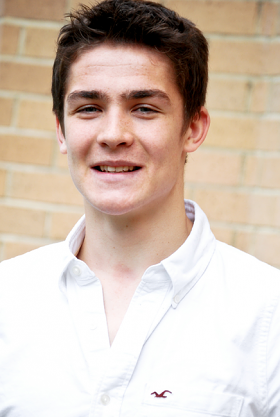
Joseph (Joe) Larvin has returned to the Unit and the group of Pete Magill to pursue his studies on the molecular architecture of globus pallidus neurons. Joe already completed a highly successful Final Honours School research project in the Unit earlier this year, as part of his BMBCH medical degree at the University of Oxford.
- Unit30 May 2013
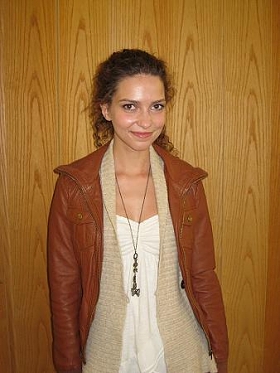
We are pleased to welcome Eszter Kormann to the Unit. Eszter has joined Professor Peter Somogyi’s lab on a short term appointment as a Research Technician. She graduated from Eötvös Loránd University with a Psychology BA in 2013.
She has gained teaching experience and has worked as an assistant lecturer and research assistant at the Institute of Cognitive Neuroscience & Psychology of the Hungarian Academy of Sciences. Her projects involved psychophysiological tests on human subject, EEG and ECG analyses.
From October she will commence her M.Sc course in Neuroscience at the University of Oxford.
- Unit27 May 2013
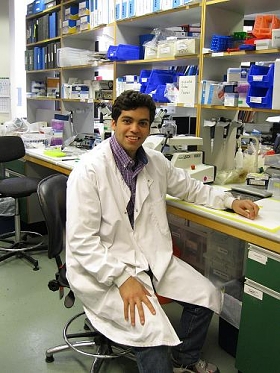
Shaady Garas has joined the group of Pete Magill to complete a summer research project as part of his B.Sc.(hons) in Health Sciences at McMaster University, Canada. As part of his research experience, Shaady will use light microscopy and immunohistochemistry to define the molecular architecture of distinct types of globus pallidus neuron.
- External21 May 2013
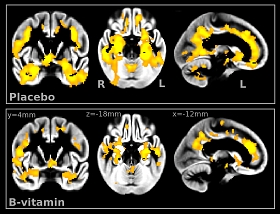 Areas of degeneration of grey matter (yellow) over a 2 year period in Alzheimer's disease patients in groups receiving placebo (top) or B vitamin treatment (bottom). [Figure 1 from Douaud et al. (2013) PNAS (early edition online ahead of print)]
Areas of degeneration of grey matter (yellow) over a 2 year period in Alzheimer's disease patients in groups receiving placebo (top) or B vitamin treatment (bottom). [Figure 1 from Douaud et al. (2013) PNAS (early edition online ahead of print)]David Smith, Honorary Associate Director of the Unit and Professor Emeritus of Pharmacology at the University of Oxford and his team has shown that large doses of three B vitamins (folic acid, vitamins B12 and B6) specifically slow the shrinkage of the brain areas vulnerable to dementia by as much as 90 per cent. David says: “Our work shows that a key part of the process that leads to Alzheimer’s disease might be modified by a safe and simple intervention.” His previous studies in the same trial showed that these doses of B vitamins can slow mental decline in the elderly who suffer from mild memory problems. Now the latest analysis of a 2010 clinical trial, part-funded by the MRC, has found that high doses of these vitamins particularly B12 can help to protect the parts of the brain affected by Alzheimer’s disease. David says that this is the first time that a treatment has been shown to modify the disease process and so it holds out the hope that other causes of brain atrophy, such as hypertension and diabetes, both of which are linked to Alzheimer's disease, can be modified to help prevent Alzheimer's disease.
External link to MRC News.
External link to article at PNAS.
- Unit21 May 2013
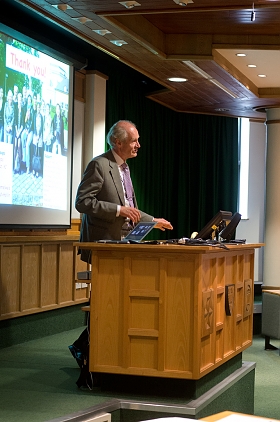
Neuropeptide signalling in health and disease.
Professor Tomas Hökfelt, Department of Neuroscience, Karolinska Institutet, Stockholm, (http://ki.se/ki/jsp/polopoly.jsp?d=25981&a=55039&l=en) delivered the 8th David Smith Lecture on the 21st May 2013, followed by dinner at Lady Margaret Hall.Professor Hökfelt is one the fathers of the field of neuropeptide research. His research focuses on the localization and function of neuropeptides in the healthy and diseased brain. He talked about three of the neuropeptide systems he had worked on, how neuropeptides or neuropeptide receptors could be novel therapeutic targets in the treatment of pain, insomnia and anxiety/depression, but how early hopes had not come to fruition. He finished on a note of optimism for future research on neuropeptides and new therapeutic targets.
The Lecture each year celebrates the vision of the previous Chair of Pharmacology and founding Director of the Unit, Prof. A. David Smith, currently Honorary Associate Director and Emeritus Professor, and the successful conclusion of the last quinquennial scientific review of the Unit.
To commemorate the lecture Prof. Hökfelt received a laser-engraved cherry-wood plaque, designed by Unit Artist, Ben Micklem, illustrating aspects of Anatomical Neuropharmacology at Oxford from molecules to the brain.
- Unit13 May 2013
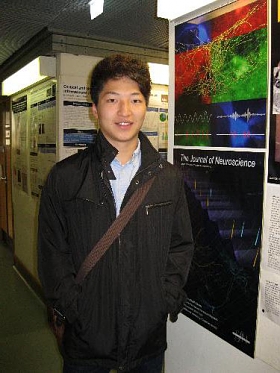
Masanori is originally from Japan, but has been studying in the UK for over 12 years. He is in his 2nd- 3rd year of Preclinical Medicine studies at Oxford University Medical School (Hertford College) and has joined Dr. R.A.J. McIlhinney laboratory to do FHS research project under supervision of Dr. Pavel Perestenko.
He has a keen interest in Medical Sciences and feels that working in the laboratory is a great way for him to appreciate the stringency of scientific techniques and methods as well as an ideal opportunity to gain specific insight into Neuroscience.
- External12 May 2013
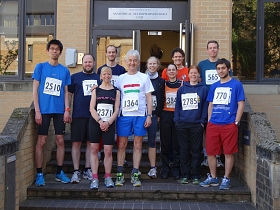
Unprecedented numbers of sporty types from the Unit braved the 10 km Town and Gown charity run supporting the Muscular Distrophy Campaign, which aimed to raise £ 100,000 this year. On the 12th of May, Kristina Detzner (52:55), Andy Sharott (53:03), Rob Stewart (38:33), Linda Katona (58:52), Michael Crump (48:58), Colin McNamara (48:45), Eleftheria Pissadaki (62:30), Ruth Faram (49:07) all improved on their pervious times, and new runners did really well: Anne Petzold (60:51), Icnelia Huerta-Ocampo (58:37), Koiuchi Nakamura (48:35) and Chad Johnson (46:05); while Director Peter Somogyi (53:25) resisted the stress of the Unit’s transfer to the University and improved on last year by 27 seconds, improving his grading to 62.21, proving yet again how good vintage improves with age. Nearly 4000 runners watched in awe as David Mulvee (31:30) won the 32nd race of this annual event (results table). From the team of The MAGYARS, daughter Lilla came in fastest at 46:32, son Levente and girlfriend Beata Turik finished hand in hand at 60:00.
- Unit10 May 2013
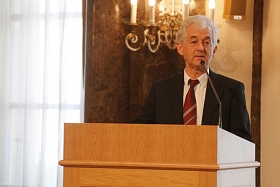
Péter Somogyi delivered the Péter Pázmány Lecture “Chronocircuit of space-specific neurons in the brain” at the Loránd Eötvös University, Budapest on the 9th of May. He was awarded the title ‘Doctor et Professor Honoris Causa’ in a ceremony on the 10th of May along with professors Dominique Combe (Paris), Helmut Koziol (Vienna) and Ferjan Ormeling (Utrecht). Prof Somogyi received his degrees MSc in biology in 1975 and Doctorate in cell biology (1977) at his alma mater. The Loránd Eötvös University is named after the physicist who worked and taught at the turn of the 19th and 20th centuries. It was founded by Bishop Péter Pázmány in 1635 and moved to Budapest later.
- External7 May 2013
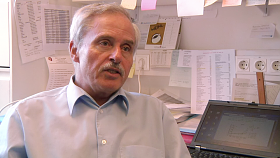
Prof Werner Sieghart, emeritus professor at the Medical University of Vienna, an internationally recognised pioneer on the structure, distribution and function of GABA-A receptors, and a long-term collaborator on several Unit programmes has been elected an Honorary Fellow of the Hungarian Academy of Sciences on the 6th of May 2013. Amongst other discoveries Prof Sieghart demonstrated the multiplicity of of GABA-A receptors using radioligand binding of allosteric modulator benzodiazepines (Sieghart and Karobath, 1980). He went on to show that distinct GABA-A receptors are differentially located in the central nervous system (Zimprich et al., 1991). More recently, he and his colleagues identified the diazepam-bound atomic structure of the GABA-A receptor using homology modelling and an unbiased docking protocol (Richter et al., 2012).